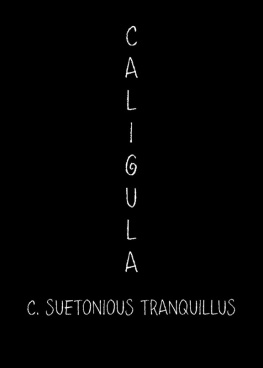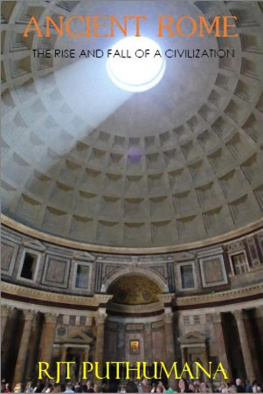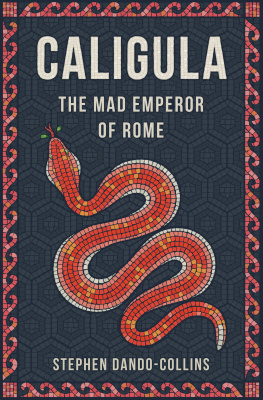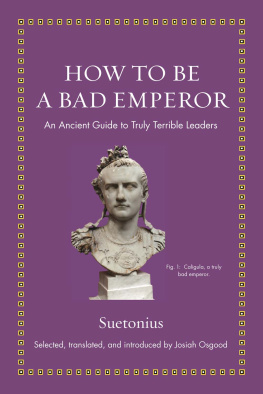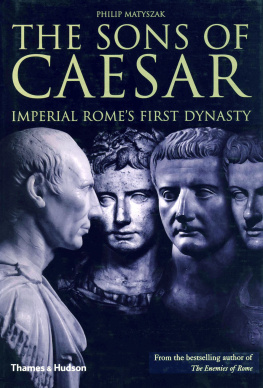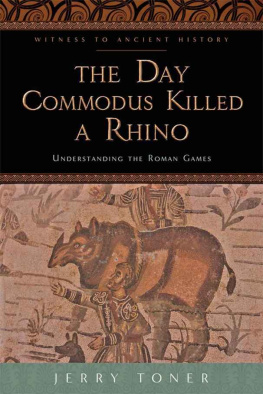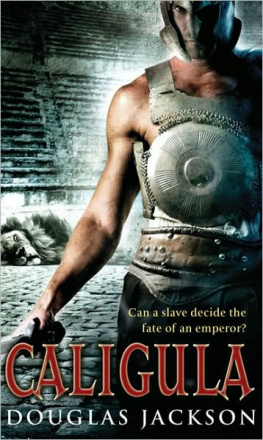
In honor of beloved Virgil
O degli altri poeti onore e lume...
Dante, Inferno
The publisher gratefully acknowledges the generous support of
the Classical Literature Endowment Fund of the University of
California Press Foundation, which was established
by a major gift from Joan Palevsky.
Caligula

Bust of Caligula. Copenhagen, Ny Carlsberg Glyptotek 637 (Inv. 1453). Photo: Ole Haupt.
Caligula
A Biography
Aloys Winterling
Translated by Deborah Lucas Schneider,
Glenn W. Most, and Paul Psoinos

University of California Press, one of the most distinguished university presses in the United States, enriches lives around the world by advancing scholarship in the humanities, social sciences, and natural sciences. Its activities are supported by the UC Press Foundation and by philanthropic contributions from individuals and institutions. For more information, visit www.ucpress.edu .
University of California Press
Berkeley and Los Angeles, California
University of California Press, Ltd.
London, England
2011 by The Regents of the University of California
German original Verlag C. H. Beck oHG, Mnchen 2003
Library of Congress Cataloging-in-Publication Data
Winterling, Aloys.
[Caligula. English]
Caligula : a biography / Aloys Winterling ; translated by Deborah
Lucas Schneider, Glenn W. Most, and Paul Psoinos
p. cm.
Originally published in German: Mnchen : C.H. Beck, c2003,
with title Caligula : eine Biographie.
Includes bibliographical references and index.
ISBN 978-0-520-24895-3 (cloth, alk. paper)
1. Caligula, Emperor of Rome, 1241. 2. RomeHistoryCaligula, 3741.
3. EmperorsRomeBiography. I. Title.
DG283.W5613 2011 |
937.07092dc22 | 2011012924 |
Manufactured in the United States of America
20 19 18 17 16 15 14 13 12 11
10 9 8 7 6 5 4 3 2 1
In keeping with its commitment to support environmentally responsible and sustainable printing practices, UC Press has printed this book on Natures Book, which contains 30% post-consumer waste and meets the minimum requirements of ANSI/NISO Z 39.48-1992 (R 1997) (Permanence of Paper).
CONTENTS
ABBREVIATIONS
Dig. | Digesta Justiniani |
Dio | Cassius Dio, Roman History |
Jos. Ant. | Flavius Josephus, Antiquitates Judaicae |
Phil. Leg. | Philo, Legatio ad Gaium |
Sen. Ad Helv. | Seneca, Ad Helviam Matrem de Consolatione |
De Const. Sap. | Seneca, De Constantia Sapientis |
Suet. Aug. | Suetonius, De Vita Caesarum libri: Augustus |
Cal. | Suetonius, De Vita Caesarum libri: Gaius Caligula |
Claud. | Suetonius, De Vita Caesarum libri: Claudius |
Tib. | Suetonius, De Vita Caesarum libri: Tiberius |
Vit. | Suetonius, De Vita Caesarum libri: Vitellius |
Tac. Ann. | Tacitus, Annales |

Figure 1. Ruling Emperors.
INTRODUCTION
A Mad Emperor?
Caligula, the man who was Roman emperor from A.D. 37 to 41, started out as a tyrannical ruler and degenerated into a monster. He drank pearls dissolved in vinegar and ate food covered with gold leaf. He forced men and women of high rank to have sex with him, turned part of his palace into a brothel, and even committed incest with his own sisters. The chief victims of his senseless cruelty were Roman senators. Torture and executions were the order of the day. He removed two consuls from office because they had forgotten his birthday. He considered himself superhuman and forced contemporaries to worship him as a god. He wanted to make his horse a consul and planned to move the capital of the Empire from Rome to Alexandria.
His biographer Suetonius, to whom we owe most of this information, and the other ancient sources have an explanation for this behavior: He was insane. The philosopher Seneca, a contemporary who knew him personally, mentions his madness and calls him a beast. Another contemporary, Philo of Alexandria, who had contact with him as the head of a legation, speaks of his insanity. Pliny the Elder and Flavius Josephus, two authors writing several decades later, mention his absurd behavior and report on his madness. At the beginning of the second century Tacitus, the most noted historian of the Roman Empire, whose account of Caligulas reign has been lost, speaks of the emperors troubled brain. Suetonius, who wrote his biography a little less than a hundred years after Caligulas death, considered him to have been mentally ill, and Cassius Dio, who wrote a voluminous history of Rome at the start of the third century, also believed that the emperor had lost his head.
No wonder, then, that modern scholarship has followed these conclusions: Imperial madness is the standard explanation. Ludwig Quidde, who made this term famous at the end of the nineteenth century, describes this disease as megalomania, carried to the point of regarding oneself as divine; disregard for all limits of law and all the rights of other individuals; brutal cruelty without purpose or reason. Although these elements are also found in other mentally ill people, the unique quality of an emperors madness lay in his position as ruler, which provides particularly fertile soil for the seeds of such a predisposition and permits them to develop unhindered in a manner that is otherwise hardly possible. For Quiddes contemporaries, however, this brief biographical sketch of Caligula had a double meaning, a hidden intention beneath the surface of the words. They saw the depiction as so clearly aimed simultaneously at another emperor, Kaiser Wilhelm II of Germanywho was certainly not insanethat Quiddes book ran through thirty printings within a short time. It also earned the author three months in prison and ended his academic career. Yet these events did not weaken the impact of his conclusions about Caligula. The author of a recent biography (published in 1991) still describes the emperor as crazy, and a recent survey of the scholarly literature contains references to his imperial madness.
Readers of this biography of Caligula thus appear to be in for quite a storyand indeed they are. Matters are considerably more complicated than might appear at first glance, however. It was established during the nineteenth century that ancient accounts of this emperor are by no means as much in agreement as they may seem. Take Caligulas sex life, for example: The claim that the emperor committed incest with his three sisters is misinformation that surfaces for the first time in Suetonius. Its hollowness is easily proved: The emperors two contemporaries Seneca and Philo, who were both familiar with aristocratic circles in Rome and well informed, heap invective on the emperor and would hardly have failed to mention such a charge had it been in circulation then. But clearly they knew nothing about it. The same holds for Tacitus. In his history of the early Empire he discusses at some length the dissolute life of the younger Agrippina, who was Caligulas sister and the wife of the later emperor Claudius. He even considers her capable of having attempted incest with her own son, the emperor Nero. Clearly he would have mentioned any incest between Agrippina and her brother, which would have suited his account, but no such allegation was known to him. Thus the story was invented at some point after Caligulas death.
Next page



